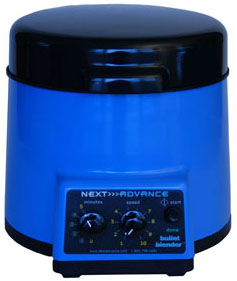Ideal for Meconium Tissue Homogenization
Do you spend lots of time and effort homogenizing meconium tissue samples? The Bullet Blender® tissue homogenizer delivers high quality and superior yields. No other homogenizer comes close to delivering the Bullet Blender’s winning combination of top-quality performance and budget-friendly affordability.
The Bullet Blender®
Save Time, Effort and Get Superior Results
- Consistent and High Yield Results
Run up to 24 samples at the same time under microprocessor-controlled conditions, ensuring experimental reproducibility and high yield. Process samples from 10mg or less up to 3.5g. - No Cross Contamination
No part of the Bullet Blender® ever touches the meconium samples – the sample tubes are kept closed during homogenization. There are no probes to clean between samples. - Samples Stay Cool
Homogenizing causes only a few degrees of heating. Our Gold models keep samples at 4ºC. - Easy and Convenient to Use
Just place beads and buffer along with your meconium sample in standard tubes, load tubes directly in the Bullet Blender, select time and speed, and press start. - Risk Free Purchase
The Bullet Blender® comes with a 30 day money back guarantee and a 2 year warranty, with a 3 year warranty on the motor. The simple, reliable design enables the Bullet Blenders to sell for a fraction of the price of ultrasonic or other agitation based instruments, yet provides an easier, quicker technique.

Bullet Blender settings for Meconium tissue
Sample size | See the Protocol |
| microcentrifuge tube model (up to 300 mg) | Small meconium samples |
| 5mL tube model (100mg – 1g) | Medium meconium samples |
| 50mL tube model (100mg – 3.5g) | Large meconium samples |
Selected publications for Meconium Samples
See all of our Bullet Blender publications!
2474232
meconium
items
1
0
date
desc
3190
https://www.nextadvance.com/wp-content/plugins/zotpress/
%7B%22status%22%3A%22success%22%2C%22updateneeded%22%3Afalse%2C%22instance%22%3A%22zotpress-5f90c3e0a43c6b4f1679c4410c03a3be%22%2C%22meta%22%3A%7B%22request_last%22%3A0%2C%22request_next%22%3A0%2C%22used_cache%22%3Atrue%7D%2C%22data%22%3A%5B%7B%22key%22%3A%228WNPXU7K%22%2C%22library%22%3A%7B%22id%22%3A2474232%7D%2C%22meta%22%3A%7B%22creatorSummary%22%3A%22Marin%20and%20McMillin%22%2C%22parsedDate%22%3A%222016%22%2C%22numChildren%22%3A0%7D%2C%22bib%22%3A%22%3Cdiv%20class%3D%5C%22csl-bib-body%5C%22%20style%3D%5C%22line-height%3A%202%3B%20padding-left%3A%201em%3B%20text-indent%3A-1em%3B%5C%22%3E%5Cn%20%20%3Cdiv%20class%3D%5C%22csl-entry%5C%22%3EMarin%2C%20S.%20J.%2C%20%26amp%3B%20McMillin%2C%20G.%20A.%20%282016%29.%20Quantitation%20of%20Total%20Buprenorphine%26%23xA0%3B%20and%20Norbuprenorphine%20in%20Meconium%20by%20LC-MS%5C%2FMS.%20In%20%3Ci%3EClinical%20Applications%20of%20Mass%20Spectrometry%20in%20Drug%20Analysis%3A%20Methods%20and%20Protocols%3C%5C%2Fi%3E%20%28Vol.%201383%2C%20pp.%2059%26%23×2013%3B68%29.%20Springer%20Science%2BBusiness%20Media.%3C%5C%2Fdiv%3E%5Cn%3C%5C%2Fdiv%3E%22%2C%22data%22%3A%7B%22itemType%22%3A%22bookSection%22%2C%22title%22%3A%22Quantitation%20of%20Total%20Buprenorphine%20%20and%20Norbuprenorphine%20in%20Meconium%20by%20LC-MS%5C%2FMS%22%2C%22creators%22%3A%5B%7B%22creatorType%22%3A%22author%22%2C%22firstName%22%3A%22Stephanie%20J%22%2C%22lastName%22%3A%22Marin%22%7D%2C%7B%22creatorType%22%3A%22author%22%2C%22firstName%22%3A%22Gwendolyn%20A%22%2C%22lastName%22%3A%22McMillin%22%7D%5D%2C%22abstractNote%22%3A%22%22%2C%22bookTitle%22%3A%22Clinical%20Applications%20of%20Mass%20Spectrometry%20in%20Drug%20Analysis%3A%20Methods%20and%20Protocols%22%2C%22date%22%3A%222016%22%2C%22language%22%3A%22%22%2C%22ISBN%22%3A%22%22%2C%22url%22%3A%22%22%2C%22collections%22%3A%5B%22M2MNG549%22%5D%2C%22dateModified%22%3A%222015-12-30T16%3A06%3A38Z%22%7D%7D%2C%7B%22key%22%3A%228RBRJNKZ%22%2C%22library%22%3A%7B%22id%22%3A2474232%7D%2C%22meta%22%3A%7B%22creatorSummary%22%3A%22Marin%20et%20al.%22%2C%22parsedDate%22%3A%222011%22%2C%22numChildren%22%3A0%7D%2C%22bib%22%3A%22%3Cdiv%20class%3D%5C%22csl-bib-body%5C%22%20style%3D%5C%22line-height%3A%202%3B%20padding-left%3A%201em%3B%20text-indent%3A-1em%3B%5C%22%3E%5Cn%20%20%3Cdiv%20class%3D%5C%22csl-entry%5C%22%3EMarin%2C%20S.%20J.%2C%20Christensen%2C%20R.%20D.%2C%20Baer%2C%20V.%20L.%2C%20Clark%2C%20C.%20J.%2C%20%26amp%3B%20McMillin%2C%20G.%20A.%20%282011%29.%20Nicotine%20and%20Metabolites%20in%20Paired%20Umbilical%20Cord%20Tissue%20and%20Meconium%20Specimens%3A%20%3Ci%3ETherapeutic%20Drug%20Monitoring%3C%5C%2Fi%3E%2C%20%3Ci%3E33%3C%5C%2Fi%3E%281%29%2C%2080%26%23×2013%3B85.%20%3Ca%20href%3D%27https%3A%5C%2F%5C%2Fdoi.org%5C%2F10.1097%5C%2FFTD.0b013e3182055f14%27%3Ehttps%3A%5C%2F%5C%2Fdoi.org%5C%2F10.1097%5C%2FFTD.0b013e3182055f14%3C%5C%2Fa%3E%3C%5C%2Fdiv%3E%5Cn%3C%5C%2Fdiv%3E%22%2C%22data%22%3A%7B%22itemType%22%3A%22journalArticle%22%2C%22title%22%3A%22Nicotine%20and%20Metabolites%20in%20Paired%20Umbilical%20Cord%20Tissue%20and%20Meconium%20Specimens%3A%22%2C%22creators%22%3A%5B%7B%22creatorType%22%3A%22author%22%2C%22firstName%22%3A%22Stephanie%20J%22%2C%22lastName%22%3A%22Marin%22%7D%2C%7B%22creatorType%22%3A%22author%22%2C%22firstName%22%3A%22Robert%20D%22%2C%22lastName%22%3A%22Christensen%22%7D%2C%7B%22creatorType%22%3A%22author%22%2C%22firstName%22%3A%22Vickie%20L%22%2C%22lastName%22%3A%22Baer%22%7D%2C%7B%22creatorType%22%3A%22author%22%2C%22firstName%22%3A%22Chantry%20J%22%2C%22lastName%22%3A%22Clark%22%7D%2C%7B%22creatorType%22%3A%22author%22%2C%22firstName%22%3A%22Gwendolyn%20A%22%2C%22lastName%22%3A%22McMillin%22%7D%5D%2C%22abstractNote%22%3A%22%22%2C%22date%22%3A%2202%5C%2F2011%22%2C%22language%22%3A%22en%22%2C%22DOI%22%3A%2210.1097%5C%2FFTD.0b013e3182055f14%22%2C%22ISSN%22%3A%220163-4356%22%2C%22url%22%3A%22http%3A%5C%2F%5C%2Fcontent.wkhealth.com%5C%2Flinkback%5C%2Fopenurl%3Fsid%3DWKPTLP%3Alandingpage%26an%3D00007691-201102000-00013%22%2C%22collections%22%3A%5B%22M2MNG549%22%5D%2C%22dateModified%22%3A%222015-07-27T15%3A49%3A45Z%22%7D%7D%5D%7D
Marin, S. J., & McMillin, G. A. (2016). Quantitation of Total Buprenorphine and Norbuprenorphine in Meconium by LC-MS/MS. In Clinical Applications of Mass Spectrometry in Drug Analysis: Methods and Protocols (Vol. 1383, pp. 59–68). Springer Science+Business Media.
Marin, S. J., Christensen, R. D., Baer, V. L., Clark, C. J., & McMillin, G. A. (2011). Nicotine and Metabolites in Paired Umbilical Cord Tissue and Meconium Specimens: Therapeutic Drug Monitoring, 33(1), 80–85. https://doi.org/10.1097/FTD.0b013e3182055f14

